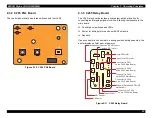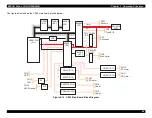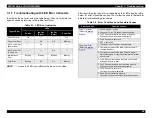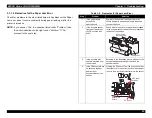
EPSON Stylus COLOR 900/900N
Chapter 2 Operating Principles
52
Linear Encoder:
The linear encoder sensor improves synchronization between ink
ejection and carriage movement. Irregular movement of the
carriage, usually caused by a paper jam, can also be detected
based on the change in output signals from this sensor.
If the printer is jarred during printing, the sensor may fail to read the
encoder strip properly. As a result, some dots may fail to print. This
is because this printhead is driven by the trapezoidal waveform,
which is produced using signals sent from the encoder.
Ink Cartridge Sensors:
The carriage unit is equipped with two sensors (micro switches) for
detecting the presence of the color and black ink cartridges. The
printer cannot operate unless both cartridges are installed and the
ink cartridge clamps are securely closed.
CR Home Position Sensor:
When the printer is turned on, the CRHP sensor confirms the CR is
in the home position during the home position seeking sequence.
The printer “memorizes” this location and uses it as a reference by
which it calculates the carriage position during printing.
PE (Paper End) Sensor:
The PE sensor detects the following conditions:
Whether paper is in the paper path at power on.
Whether the ASF has loaded paper properly after the printer
receives a paper feed command.
Whether the printer has properly ejected a page after rotating
the PF (Paper Feed) motor the predefined distance.
ASF Sensor:
In order to load paper properly, the ASF and paper feed rollers must
work in a coordinated manner. If the timing is wrong, the paper may
fail to feed or a paper jam may occur. The ASF home position
sensor monitors the ASF’s condition at power-on and during paper
feeding to ensure that the proper timing it achieved.
Power Control Signal:
The power supply of the EPSON Stylus COLOR 900/900N is not
controlled by a primary line switch. Instead, the power switch on the
control panel sends a signal to the ASIC E05B60 (IC3) on the C265
main board. When the power switch on the control panel is turned
off, the change from 5 V to ground level is detected at pin 33 of IC3,
and the printer begins its power off sequence (paper ejection and
printhead capping). The power supply remains on long enough for
the printer to complete the power off sequence. After a pre-
determined delay, the power supply shuts itself off.
Summary of Contents for 900N
Page 1: ...EPSONStylusCOLOR900 900N Color ink jet printer TM SC900 N 6 59 0 18 ...
Page 8: ... 37 5 PRODUCTDESCRIPTION ...
Page 37: ... 37 5 OPERATINGPRINCIPLES ...
Page 67: ... 37 5 TROUBLESHOOTING ...
Page 89: ... 37 5 DISASSEMBLYANDASSEMBLY ...
Page 121: ... 37 5 ADJUSTMENTS ...
Page 156: ... 37 5 MAINTENANCE ...
Page 169: ... 37 5 APPENDIX ...
Page 179: ...EPSON Stylus COLOR 900 900N Chapter 7 Appendix 176 Figure 7 3 C265 Main Board Soldering side ...
Page 181: ...EPSON Stylus COLOR 900 900N Chapter 7 Appendix 178 Figure 7 6 C265 PNL Board ...
Page 195: ...06 03 01 02 for S E ASIA 03 03 05 03 04 EPSON STYLUS COLOR 900 No 7 10056 Rev 01 ...
Page 197: ......
Page 198: ......
Page 199: ......
Page 200: ......
Page 201: ......
















































